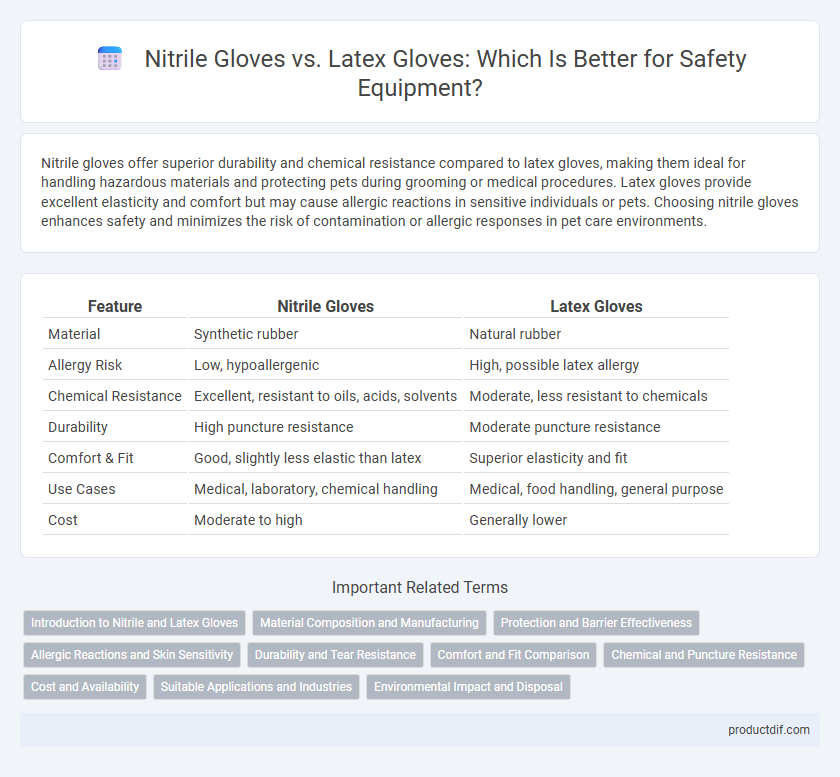Nitrile gloves offer superior durability and chemical resistance compared to latex gloves, making them ideal for handling hazardous materials and protecting pets during grooming or medical procedures. Latex gloves provide excellent elasticity and comfort but may cause allergic reactions in sensitive individuals or pets. Choosing nitrile gloves enhances safety and minimizes the risk of contamination or allergic responses in pet care environments.
Table of Comparison
| Feature | Nitrile Gloves | Latex Gloves |
|---|---|---|
| Material | Synthetic rubber | Natural rubber |
| Allergy Risk | Low, hypoallergenic | High, possible latex allergy |
| Chemical Resistance | Excellent, resistant to oils, acids, solvents | Moderate, less resistant to chemicals |
| Durability | High puncture resistance | Moderate puncture resistance |
| Comfort & Fit | Good, slightly less elastic than latex | Superior elasticity and fit |
| Use Cases | Medical, laboratory, chemical handling | Medical, food handling, general purpose |
| Cost | Moderate to high | Generally lower |
Introduction to Nitrile and Latex Gloves
Nitrile gloves are synthetic rubber gloves known for high chemical resistance and hypoallergenic properties, making them ideal for users with latex allergies. Latex gloves, derived from natural rubber, offer superior elasticity, comfort, and tactile sensitivity, commonly used in medical and laboratory environments. Both types provide effective protection but differ in durability, allergenic potential, and suitability for specific safety applications.
Material Composition and Manufacturing
Nitrile gloves are made from synthetic rubber polymers derived from acrylonitrile and butadiene, offering superior chemical resistance and durability compared to natural latex gloves, which are composed of natural rubber latex harvested from rubber trees. The manufacturing process of nitrile gloves involves polymerization and vulcanization techniques that enhance elasticity and puncture resistance, whereas latex gloves undergo a natural coagulation process and may include proteins that can cause allergic reactions. Advanced synthetic formulations in nitrile gloves allow for consistent thickness and strength, making them preferable in environments requiring stringent safety and hygiene standards.
Protection and Barrier Effectiveness
Nitrile gloves offer superior protection against chemicals, punctures, and allergens compared to latex gloves, making them ideal for environments with exposure to hazardous substances. Latex gloves provide excellent elasticity and tactile sensitivity but pose allergy risks due to natural rubber proteins. Both types create effective barriers against pathogens, yet nitrile's enhanced resistance to oils and solvents ensures greater overall protection in demanding safety applications.
Allergic Reactions and Skin Sensitivity
Nitrile gloves offer superior protection for individuals with latex allergies, as they are made from synthetic rubber that does not contain natural proteins responsible for allergic reactions. Latex gloves, while flexible and comfortable, frequently cause skin sensitivity and allergic dermatitis in sensitive users due to the presence of natural rubber latex proteins. Choosing nitrile gloves minimizes the risk of contact dermatitis and IgE-mediated allergic responses, making them a safer option in environments requiring prolonged glove use.
Durability and Tear Resistance
Nitrile gloves demonstrate superior durability and tear resistance compared to latex gloves, making them ideal for high-risk tasks in medical and industrial settings. Their synthetic composition resists punctures and abrasions better than natural latex, extending glove lifespan under strenuous conditions. This enhanced toughness reduces the frequency of glove replacements, saving costs and maintaining consistent protection.
Comfort and Fit Comparison
Nitrile gloves offer superior comfort for those with latex allergies, providing a snug fit that reduces hand fatigue during extended use. Latex gloves are known for their excellent elasticity and close fit, allowing for greater dexterity and tactile sensitivity in precision tasks. Both materials deliver reliable comfort, but nitrile's enhanced flexibility and hypoallergenic properties make it preferable for users seeking all-day wearability and reduced skin irritation.
Chemical and Puncture Resistance
Nitrile gloves offer superior chemical resistance against oils, solvents, and certain acids compared to latex gloves, which can degrade more quickly when exposed to harsh chemicals. Puncture resistance in nitrile gloves is significantly higher due to their synthetic rubber composition, providing better protection against sharp objects and infectious materials. Latex gloves, while flexible and comfortable, have lower resistance to punctures and specific chemicals, making nitrile gloves a preferred choice for environments with chemical exposure and high-risk puncture hazards.
Cost and Availability
Nitrile gloves generally cost more than latex gloves due to their synthetic material and enhanced chemical resistance. Latex gloves are widely available and offer lower prices, making them a cost-effective choice for many industries. However, nitrile gloves have gained popularity for their allergy-free properties and robust availability in medical and industrial markets.
Suitable Applications and Industries
Nitrile gloves are preferred in medical, chemical, and food processing industries due to their superior resistance to punctures, chemicals, and allergens, making them ideal for healthcare, laboratories, and manufacturing environments. Latex gloves offer excellent elasticity and comfort, widely used in dental, veterinary, and cleaning sectors where tactile sensitivity and biodegradability are important. Both glove types ensure protection, but nitrile is favored in settings requiring high chemical resistance and allergy prevention.
Environmental Impact and Disposal
Nitrile gloves offer a lower environmental impact compared to latex gloves due to their synthetic composition, which avoids the use of natural rubber harvesting processes that can contribute to deforestation. However, nitrile gloves are less biodegradable and often require specialized disposal methods to prevent landfill accumulation and microplastic pollution. Latex gloves, made from natural rubber, biodegrade more quickly but can cause environmental allergic reactions and need proper waste management to minimize ecological harm.
Nitrile gloves vs Latex gloves Infographic

 productdif.com
productdif.com